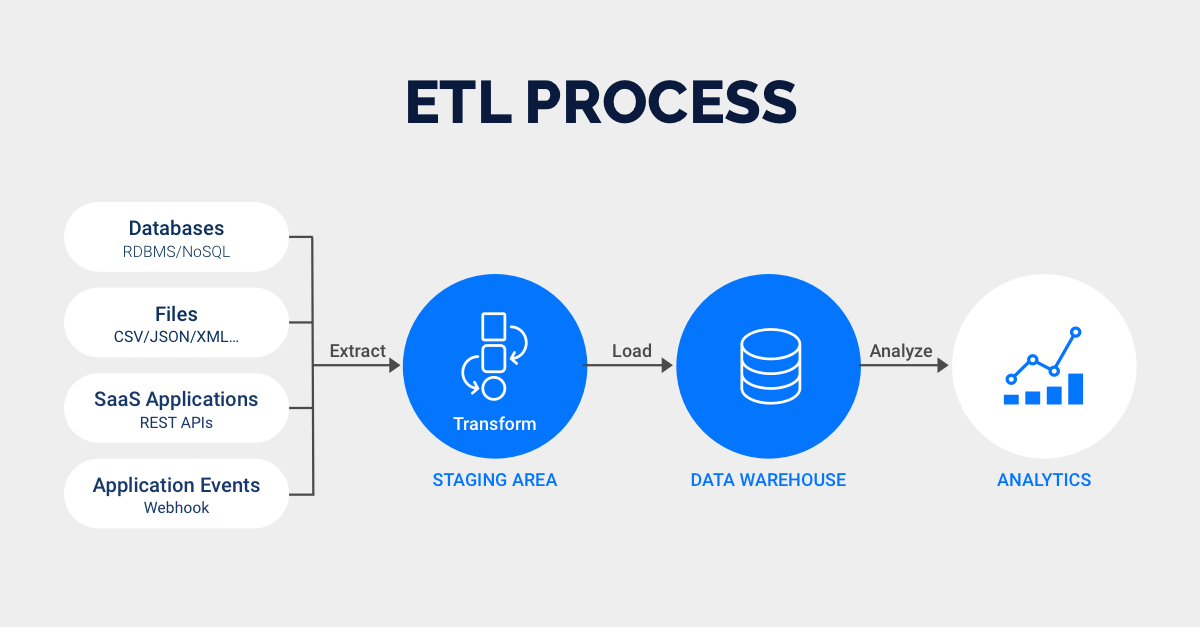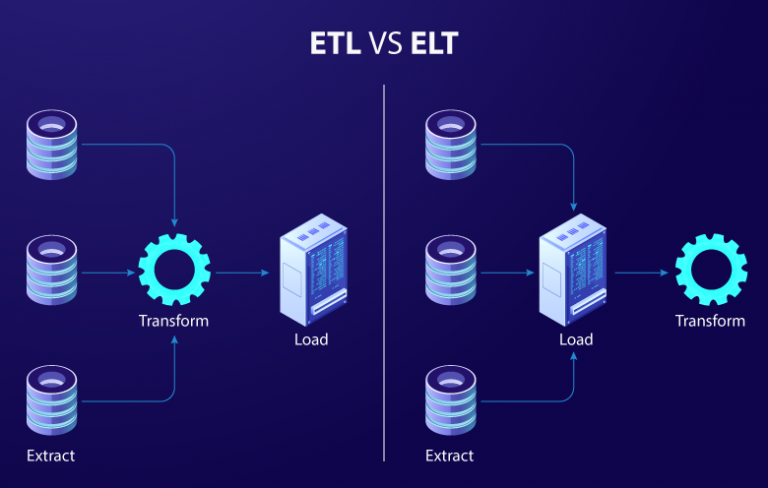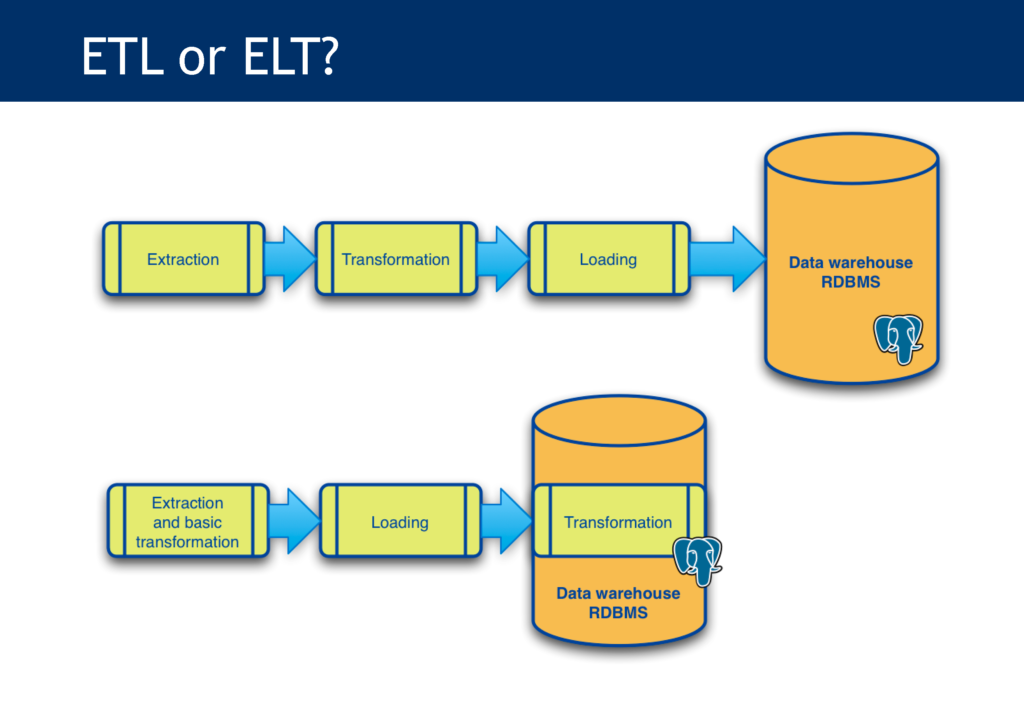What is ETL?

ETL stands for Extract, Transform, Load. This process is used to integrate data from multiple sources into a single destination, such as a data warehouse. The process involves extracting data from the source systems, transforming it into a format that can be used by the destination system, and then loading it into the destination system. ETL is commonly used in business intelligence and data warehousing projects to consolidate data from various sources and make it available for analysis and reporting.
What is ELT?

ELT stands for Extract, Load, Transform. It is a process similar to ETL but with a different order of operations. In ELT, data is first extracted from source systems and loaded into the destination system, and then transformed into a format that can be used for analysis and reporting. This approach is often used when the destination system has the capability to perform complex transformations and data manipulation. ELT is becoming more popular with the rise of cloud-based data warehouses and big data platforms that can handle large-scale data processing and transformation.
Here’s What Makes these Two Different:

ETL (Extract, Transform, Load) and ELT (Extract, Load, Transform) are two methods of data integration used in data warehousing.
ETL involves extracting data from various sources, transforming it into a format that can be used by the target system, and then loading it into the target system. The transformation process involves cleaning, validating, and enriching the data before it is loaded. ETL is a batch-oriented process that requires a significant amount of computing power and storage space.
Conversely, ELT involves extracting data from various sources and loading it directly into the target system without any transformation. The transformation process is performed after the data has been loaded into the target system. ELT is a more modern approach that takes advantage of the processing power of modern data warehouses and allows for real-time analysis of data.
The main difference between ETL and ELT is the order in which the transformation process is performed. In ETL, transformation is performed before loading, while in ELT, transformation is performed after loading. The choice between ETL and ELT depends on the specific needs of the organization and the characteristics of the data being integrated.
How is ELT Different from ETL and What are its Advantages and Disadvantages.
Advantages of ELT over ETL:
- Faster processing: ELT can process data faster than ETL because it eliminates the need for a separate transformation tool.
- Lower latency: ELT can provide lower latency in data processing because it can load data directly into the data warehouse without the need for intermediate storage.
- More efficient use of resources: ELT can make more efficient use of computing resources because it can leverage the processing power of the data warehouse.
- Better support for big data: ELT is better suited for big data environments because it can handle large volumes of data without the need for additional infrastructure.
Disadvantages of ELT over ETL:
- Dependency on data warehouse: ELT processes are dependent on the availability and compatibility of the data warehouse, which can cause delays or failures in data integration.
- Complexity: ELT requires a high level of technical expertise and may be more difficult to implement than ETL.
- Data quality issues: ELT can result in data quality issues if not properly designed or executed, leading to inaccuracies or incomplete data in the data warehouse.
- Security risks: ELT processes can introduce security risks if sensitive data is not properly protected during extraction, loading, and transformation.
So which approach to choose, ETL or ELT?

ETL (Extract, Transform, Load) and ELT (Extract, Load, Transform) are two approaches to data integration that are widely used in the industry. Both ETL and ELT are used to extract data from multiple sources, transform it into a format that can be used by the target system, and load it into the target system. However, there are some key differences between the two approaches.
ETL (Extract, Transform, Load):
ETL is a traditional approach to data integration that has been used for many years. In this approach, data is first extracted from various sources and then transformed into a format that can be used by the target system. The transformed data is then loaded into the target system. ETL is a batch process that is usually done on a scheduled basis.
The main advantage of ETL is that it allows for complex transformations to be performed on the data before it is loaded into the target system. This means that data can be cleaned, filtered, and enriched before it is used. ETL also allows for data to be consolidated from multiple sources, which can be useful when data is spread across different systems.
However, ETL can be slow and resource intensive. Because the transformations are performed before the data is loaded into the target system, large amounts of data can take a long time to process. ETL also requires a dedicated server or cluster to perform the transformations.
Example of ETL:
A company wants to integrate data from multiple sources, including sales data from its CRM system and financial data from its accounting software. They use an ETL tool to extract the data, transform it into a common format, and load it into a data warehouse. The ETL process includes cleaning and filtering the data and performing calculations to create new metrics. The transformed data is then used for reporting and analysis.
ELT (Extract, Load, Transform):
ELT is a newer approach to data integration that has become popular in recent years. In this approach, data is first extracted from various sources and then loaded into the target system. Once the data is in the target system it is transformed into a format that can be used by the system.
The main advantage of ELT is that it is faster and more scalable than ETL. Because the transformations are performed after the data is loaded into the target system, large amounts of data can be processed quickly. ELT also requires less hardware than ETL, as the transformations can be performed on the target system itself.
However, ELT is not suitable for complex transformations. Because the transformations are performed after the data is loaded into the target system, there are limitations on what can be done with the data. ELT is also not suitable for consolidating data from multiple sources, as the data must be loaded into the target system before it can be combined.
Example of ELT:
A company wants to migrate its on-premises database to the cloud. They use an ELT tool to extract the data from the on-premises database and load it into the cloud database. Once the data is in the cloud database, they use SQL queries and other tools to transform the data into the desired format. The ELT process is faster and more scalable than ETL, as it does not require a dedicated server or cluster for transformations.
Conclusion:
In conclusion, both ETL and ELT have their advantages and disadvantages. ETL is best suited for situations where complex transformations are required and where data needs to be consolidated from multiple sources. ELT is best suited for situations where speed and scalability are important and where simple transformations are sufficient. Ultimately, the choice between ETL and ELT will depend on the specific needs of the organization and the nature of the data being integrated.
Please share your thoughts and suggestions in the space below, and I’ll do my best to respond to all of them as time allows.
For more such blogs click here
Happy Reading!





Very Nice Blog Anshu!!!!!!!!!! keep going
Keep up the amazing work ! Awesome blog
Very informative blog Anshu!!!! I hope more blogs are in the queue. 👌
Worth reading…!! Keep writing Anshu…!
knowledgable blog Anshu, keep it up!!
This blog is truly outstanding. The content is well-researched and informative, providing valuable insights on the topic.
This blog is absolutely incredible! The author has done a fantastic job of providing insightful and well-researched content.
Very Good Blog Anshu!!!!!!!!!! keep going
Cool blog like me !
Very informative blog Anshu!
One wadapav will be given to everyone who commented!
Intelligent blog like me!
Nice Blog! Keep it up!!